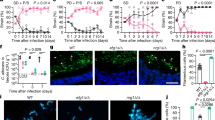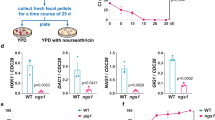Abstract
Among ∼5,000,000 fungal species1, C. albicans is exceptional in its lifelong association with humans, either within the gastrointestinal microbiome or as an invasive pathogen2. Opportunistic infections are generally ascribed to defective host immunity3 but may require specific microbial programs. Here we report that exposure of C. albicans to the mammalian gut triggers a developmental switch, driven by the Wor1 transcription factor, to a commensal cell type. Wor1 expression was previously observed only in rare genetic backgrounds4,5,6, where it controls a white-opaque switch in mating4,5,6,7. We show that passage of wild-type cells through the mouse gastrointestinal tract triggers WOR1 expression and a novel phenotypic switch. The resulting GUT (gastrointestinally induced transition) cells differ morphologically and functionally from previously defined cell types, including opaque cells, and express a transcriptome that is optimized for the digestive tract. The white-GUT switch illuminates how a microorganism can use distinct genetic programs to transition between commensalism and invasive pathogenesis.
This is a preview of subscription content, access via your institution
Access options
Subscribe to this journal
Receive 12 print issues and online access
$209.00 per year
only $17.42 per issue
Buy this article
- Purchase on Springer Link
- Instant access to full article PDF
Prices may be subject to local taxes which are calculated during checkout




Similar content being viewed by others
Accession codes
References
Blackwell, M. The fungi: 1, 2, 3 ... 5.1 million species? Am. J. Bot. 98, 426–438 (2011).
Odds, F.C. Candida and Candidosis, a Review and Bibliography (W.B. Saunders, London, 1988).
Casadevall, A. & Pirofski, L.A. Accidental virulence, cryptic pathogenesis, martians, lost hosts, and the pathogenicity of environmental microbes. Eukaryot. Cell 6, 2169–2174 (2007).
Huang, G. et al. Bistable expression of WOR1, a master regulator of white-opaque switching in Candida albicans. Proc. Natl. Acad. Sci. USA 103, 12813–12818 (2006).
Srikantha, T. et al. TOS9 regulates white-opaque switching in Candida albicans. Eukaryot. Cell 5, 1674–1687 (2006).
Zordan, R.E., Galgoczy, D.J. & Johnson, A.D. Epigenetic properties of white-opaque switching in Candida albicans are based on a self-sustaining transcriptional feedback loop. Proc. Natl. Acad. Sci. USA 103, 12807–12812 (2006).
Miller, M.G. & Johnson, A.D. White-opaque switching in Candida albicans is controlled by mating-type locus homeodomain proteins and allows efficient mating. Cell 110, 293–302 (2002).
Edmond, M.B. et al. Nosocomial bloodstream infections in United States hospitals: a three-year analysis. Clin. Infect. Dis. 29, 239–244 (1999).
Zaoutis, T.E. et al. The epidemiology and attributable outcomes of candidemia in adults and children hospitalized in the United States: a propensity analysis. Clin. Infect. Dis. 41, 1232–1239 (2005).
Odds, F.C. et al. Candida albicans strain maintenance, replacement, and microvariation demonstrated by multilocus sequence typing. J. Clin. Microbiol. 44, 3647–3658 (2006).
Chen, C., Pande, K., French, S.D., Tuch, B.B. & Noble, S.M. An iron homeostasis regulatory circuit with reciprocal roles in Candida albicans commensalism and pathogenesis. Cell Host Microbe 10, 118–135 (2011).
Pierce, J.V. & Kumamoto, C.A. Variation in Candida albicans EFG1 expression enables host-dependent changes in colonizing fungal populations. MBio 3, e00117–12 (2012).
Zordan, R.E., Miller, M.G., Galgoczy, D.J., Tuch, B.B. & Johnson, A.D. Interlocking transcriptional feedback loops control white-opaque switching in Candida albicans. PLoS Biol. 5, e256 (2007).
Noble, S.M. & Johnson, A.D. Strains and strategies for large-scale gene deletion studies of the diploid human fungal pathogen Candida albicans. Eukaryot. Cell 4, 298–309 (2005).
Camilli, A., Beattie, D.T. & Mekalanos, J.J. Use of genetic recombination as a reporter of gene expression. Proc. Natl. Acad. Sci. USA 91, 2634–2638 (1994).
Staib, P. et al. Host-induced, stage-specific virulence gene activation in Candida albicans during infection. Mol. Microbiol. 32, 533–546 (1999).
Buchholz, F., Ringrose, L., Angrand, P.O., Rossi, F. & Stewart, A.F. Different thermostabilities of FLP and Cre recombinases: implications for applied site-specific recombination. Nucleic Acids Res. 24, 4256–4262 (1996).
Slutsky, B. et al. “White-opaque transition”: a second high-frequency switching system in Candida albicans. J. Bacteriol. 169, 189–197 (1987).
Bennett, R.J. & Johnson, A.D. Mating in Candida albicans and the search for a sexual cycle. Annu. Rev. Microbiol. 59, 233–255 (2005).
Wilson, M. The gastrointestinal tract and its indigenous microbiota. in Microbial Inhabitants of Humans 251–317 (University of Cambridge Press, Cambridge, 2005).
Naglik, J.R., Challacombe, S.J. & Hube, B. Candida albicans secreted aspartyl proteinases in virulence and pathogenesis. Microbiol. Mol. Biol. Rev. 67, 400–428 (2003).
Jackson, B.E., Wilhelmus, K.R. & Hube, B. The role of secreted aspartyl proteinases in Candida albicans keratitis. Invest. Ophthalmol. Vis. Sci. 48, 3559–3565 (2007).
Wong, J.M. & Jenkins, D.J. Carbohydrate digestibility and metabolic effects. J. Nutr. 137, 2539S–2546S (2007).
Goodman, M.J., Kent, P.W. & Truelove, S.C. Glucosamine synthetase activity of the colonic mucosa in ulcerative colitis and Crohn's disease. Gut 18, 219–228 (1977).
Hill, D.A. & Artis, D. Intestinal bacteria and the regulation of immune cell homeostasis. Annu. Rev. Immunol. 28, 623–667 (2010).
Miret, S., Simpson, R.J. & McKie, A.T. Physiology and molecular biology of dietary iron absorption. Annu. Rev. Nutr. 23, 283–301 (2003).
Pierre, J.L., Fontecave, M. & Crichton, R.R. Chemistry for an essential biological process: the reduction of ferric iron. Biometals 15, 341–346 (2002).
Lan, C.Y. et al. Metabolic specialization associated with phenotypic switching in Candida albicans. Proc. Natl. Acad. Sci. USA 99, 14907–14912 (2002).
Lockhart, S.R., Wu, W., Radke, J.B., Zhao, R. & Soll, D.R. Increased virulence and competitive advantage of a/α over a/a or α/α offspring conserves the mating system of Candida albicans. Genetics 169, 1883–1890 (2005).
Xie, J. et al. White-opaque switching in natural MTL a/α isolates of Candida albicans: evolutionary implications for roles in host adaptation, pathogenesis, and sex. PLoS Biol. 11, e1001525 (2013).
Legrand, M. et al. Homozygosity at the MTL locus in clinical strains of Candida albicans: karyotypic rearrangements and tetraploid formation. Mol. Microbiol. 52, 1451–1462 (2004).
Lockhart, S.R. et al. In Candida albicans, white-opaque switchers are homozygous for mating type. Genetics 162, 737–745 (2002).
Gillum, A.M., Tsay, E.Y. & Kirsch, D.R. Isolation of the Candida albicans gene for orotidine-5′-phosphate decarboxylase by complementation of S. cerevisiae ura3 and E. coli pyrF mutations. Mol. Gen. Genet. 198, 179–182 (1984).
Oldenburg, K.R., Vo, K.T., Michaelis, S. & Paddon, C. Recombination-mediated PCR-directed plasmid construction in vivo in yeast. Nucleic Acids Res. 25, 451–452 (1997).
Mitrovich, Q.M., Tuch, B.B., Guthrie, C. & Johnson, A.D. Computational and experimental approaches double the number of known introns in the pathogenic yeast Candida albicans. Genome Res. 17, 492–502 (2007).
Reuss, O., Vik, A., Kolter, R. & Morschhauser, J. The SAT1 flipper, an optimized tool for gene disruption in Candida albicans. Gene 341, 119–127 (2004).
Guthrie, C. & Fink, C.G. Guide to Yeast Genetics and Molecular and Cell Biology (Academic Press, San Diego, 2002).
Lemoine, S., Combes, F., Servant, N. & Le Crom, S. Goulphar: rapid access and expertise for standard two-color microarray normalization methods. BMC Bioinformatics 7, 467 (2006).
Townsend, J.P. & Hartl, D.L. Bayesian analysis of gene expression levels: statistical quantification of relative mRNA level across multiple strains or treatments. Genome Biol. 3, RESEARCH0071 (2002).
Lin, C.H., Choi, A. & Bennett, R.J. Defining pheromone-receptor signaling in Candida albicans and related asexual Candida species. Mol. Biol. Cell 22, 4918–4930 (2011).
Inglis, D.O. et al. The Candida genome database incorporates multiple Candida species: multispecies search and analysis tools with curated gene and protein information for Candida albicans and Candida glabrata. Nucleic Acids Res. 40, D667–D674 (2012).
Acknowledgements
We are grateful to R. Bennett for providing protocols for C. albicans scanning electron microscopy and response to mating pheromone and to A. Johnson (University of California at San Francisco) for strains and antibodies to α-Wor1. We thank S. Beyhan and M. Voorhies for guidance with BAGEL software. M. Mwangi assisted with the preparation of images of GUT and opaque cells and with colony PCR. J. Cox, H. Madhani, Q. Mitrovich and A. Sil provided helpful comments on the manuscript. This work was supported by US National Institutes of Health (NIH) grant R21AI099659-01, a University of California at San Francisco (UCSF) Program for Breakthrough Biomedical Research award, a Burroughs Wellcome Fund CABS (Career Awards in the Biomedical Sciences) award and a Pew Foundation scholarship.
Author information
Authors and Affiliations
Contributions
K.P. identified C. albicans mutants with altered commensal fitness, characterized the white-GUT switch and analyzed mating and pheromone response. C.C. performed strain construction, expression profiling and scanning electron microscopy. S.M.N. oversaw the work and wrote the manuscript.
Corresponding author
Ethics declarations
Competing interests
The authors declare no competing financial interests.
Supplementary information
Supplementary Text and Figures
Supplementary Figures 1–7 and Supplementary Tables 1, 2 and 4–7 (PDF 3813 kb)
Supplementary table 3
Transcriptome analysis of GUT, white and opaque cells (XLSX 4305 kb)
Rights and permissions
About this article
Cite this article
Pande, K., Chen, C. & Noble, S. Passage through the mammalian gut triggers a phenotypic switch that promotes Candida albicans commensalism. Nat Genet 45, 1088–1091 (2013). https://doi.org/10.1038/ng.2710
Received:
Accepted:
Published:
Issue Date:
DOI: https://doi.org/10.1038/ng.2710
This article is cited by
-
The interactions of Candida albicans with gut bacteria: a new strategy to prevent and treat invasive intestinal candidiasis
Gut Pathogens (2023)
-
Candida albicans exploits N-acetylglucosamine as a gut signal to establish the balance between commensalism and pathogenesis
Nature Communications (2023)
-
Multifactor transcriptional control of alternative oxidase induction integrates diverse environmental inputs to enable fungal virulence
Nature Communications (2023)
-
Commensal fungi in intestinal health and disease
Nature Reviews Gastroenterology & Hepatology (2023)
-
Morphogenic plasticity: the pathogenic attribute of Candida albicans
Current Genetics (2023)



